面试的时候,栈和队列经常会成对出现来考察。本文包含栈和队列的如下考试内容:
(1)栈的创建
(2)队列的创建
(3)两个栈实现一个队列
(4)两个队列实现一个栈
(5)设计含最小函数min()的栈,要求min、push、pop、的时间复杂度都是O(1)
(6)判断栈的push和pop序列是否一致
1、栈的创建:
我们接下来通过链表的形式来创建栈,方便扩充。
代码实现:
public class Stack { public Node head; public Node current; //方法:入栈操作
public void push(int data) { if (head == null) {
head = new Node(data);
current = head;
} else {
Node node = new Node(data);
node.pre = current;//current结点将作为当前结点的前驱结点
current = node; //让current结点永远指向新添加的那个结点
}
} public Node pop() { if (current == null) { return null;
}
Node node = current; // current结点是我们要出栈的结点
current = current.pre; //每出栈一个结点后,current后退一位
return node;
} class Node { int data;
Node pre; //我们需要知道当前结点的前一个结点
public Node(int data) { this.data = data;
}
} public static void main(String[] args) {
Stack stack = new Stack();
stack.push(1);
stack.push(2);
stack.push(3);
System.out.println(stack.pop().data);
System.out.println(stack.pop().data);
System.out.println(stack.pop().data);
}
}入栈操作时,14、15行代码是关键。
运行效果:
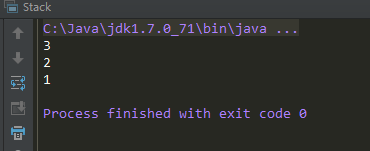
2、队列的创建:
队列的创建有两种形式:基于数组结构实现(顺序队列)、基于链表结构实现(链式队列)。
我们接下来通过链表的形式来创建队列,这样的话,队列在扩充时会比较方便。队列在出队时,从头结点head开始。
代码实现:
入栈时,和在普通的链表中添加结点的操作是一样的;出队时,出的永远都是head结点。
public class Queue { public Node head; public Node curent; //方法:链表中添加结点
public void add(int data) { if (head == null) {
head = new Node(data);
curent = head;
} else {
curent.next = new Node(data);
curent = curent.next;
}
} //方法:出队操作
public int pop() throws Exception { if (head == null) { throw new Exception("队列为空");
}
Node node = head; //node结点就是我们要出队的结点
head = head.next; //出队之后,head指针向下移
return node.data;
} class Node { int data;
Node next; public Node(int data) { this.data = data;
}
} public static void main(String[] args) throws Exception {
Queue queue = new Queue(); //入队操作
for (int i = 0; i < 5; i++) {
queue.add(i);
} //出队操作
System.out.println(queue.pop());
System.out.println(queue.pop());
System.out.println(queue.pop());
}
}运行效果:
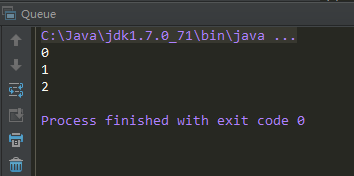
3、两个栈实现一个队列:
思路:
栈1用于存储元素,栈2用于弹出元素,负负得正。
说的通俗一点,现在把数据1、2、3分别入栈一,然后从栈一中出来(3、2、1),放到栈二中,那么,从栈二中出来的数据(1、2、3)就符合队列的规律了,即负负得正。
完整版代码实现:
import java.util.Stack;/**
* Created by smyhvae on 2015/9/9.
*/public class Queue { private Stack<Integer> stack1 = new Stack<>();//执行入队操作的栈
private Stack<Integer> stack2 = new Stack<>();//执行出队操作的栈
//方法:给队列增加一个入队的操作
public void push(int data) {
stack1.push(data);
} //方法:给队列正价一个出队的操作
public int pop() throws Exception { if (stack2.empty()) {//stack1中的数据放到stack2之前,先要保证stack2里面是空的(要么一开始就是空的,要么是stack2中的数据出完了),不然出队的顺序会乱的,这一点很容易忘
while (!stack1.empty()) {
stack2.push(stack1.pop());//把stack1中的数据出栈,放到stack2中【核心代码】
}
} if (stack2.empty()) { //stack2为空时,有两种可能:1、一开始,两个栈的数据都是空的;2、stack2中的数据出完了
throw new Exception("队列为空");
} return stack2.pop();
} public static void main(String[] args) throws Exception {
Queue queue = new Queue(); queue.push(1); queue.push(2); queue.push(3);
System.out.println(queue.pop()); queue.push(4);
System.out.println(queue.pop());
System.out.println(queue.pop());
System.out.println(queue.pop());
}
}注意第22行和第30行代码的顺序,以及注释,需要仔细理解其含义。
运行效果:
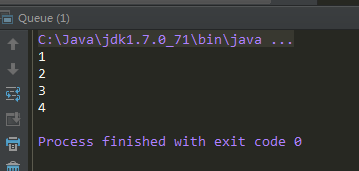
4、两个队列实现一个栈:
思路:
将1、2、3依次入队列一, 然后最上面的3留在队列一,将下面的2、3入队列二,将3出队列一,此时队列一空了,然后把队列二中的所有数据入队列一;将最上面的2留在队列一,将下面的3入队列二。。。依次循环。
代码实现:
import java.util.ArrayDeque;
import java.util.Queue;/**
* Created by smyhvae on 2015/9/9.
*/public class Stack {
Queue<Integer> queue1 = new ArrayDeque<Integer>();
Queue<Integer> queue2 = new ArrayDeque<Integer>(); //方法:入栈操作
public void push(int data) {
queue1.add(data);
} //方法:出栈操作
public int pop() throws Exception { int data; if (queue1.size() == 0) { throw new Exception("栈为空");
} while (queue1.size() != 0) { if (queue1.size() == 1) {
data = queue1.poll(); while (queue2.size() != 0) { //把queue2中的全部数据放到队列一中
queue1.add(queue2.poll()); return data;
}
}
queue2.add(queue1.poll());
} throw new Exception("栈为空");//不知道这一行的代码是什么意思
} public static void main(String[] args) throws Exception {
Stack stack = new Stack(); stack.push(1); stack.push(2); stack.push(3);
System.out.println(stack.pop());
System.out.println(stack.pop()); stack.push(4);
}
}运行效果:
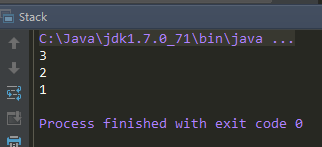
5、设计含最小函数min()的栈,要求min、push、pop、的时间复杂度都是O(1)。min方法的作用是:就能返回是栈中的最小值。【微信面试题】
普通思路:
一般情况下,我们可能会这么想:利用min变量,每次添加元素时,都和min元素作比较,这样的话,就能保证min存放的是最小值。但是这样的话,会存在一个问题:如果最小的元素出栈了,那怎么知道剩下的元素中哪个是最小的元素呢?
改进思路:
这里需要加一个辅助栈,用空间换取时间。辅助栈中,栈顶永远保存着当前栈中最小的数值。具体是这样的:原栈中,每次添加一个新元素时,就和辅助栈的栈顶元素相比较,如果新元素小,就把新元素的值放到辅助栈中,如果新元素大,就把辅助栈的栈顶元素再copy一遍放到辅助栈的栈顶;原栈中,出栈时,
完整代码实现:
import java.util.Stack;/**
* Created by smyhvae on 2015/9/9.
*/public class MinStack { private Stack<Integer> stack = new Stack<Integer>(); private Stack<Integer> minStack = new Stack<Integer>(); //辅助栈:栈顶永远保存stack中当前的最小的元素
public void push(int data) { stack.push(data); //直接往栈中添加数据
//在辅助栈中需要做判断
if (minStack.size() == 0 || data < minStack.peek()) {
minStack.push(data);
} else {
minStack.add(minStack.peek()); //【核心代码】peek方法返回的是栈顶的元素
}
} public int pop() throws Exception { if (stack.size() == 0) { throw new Exception("栈中为空");
} int data = stack.pop();
minStack.pop(); //核心代码
return data;
} public int min() throws Exception { if (minStack.size() == 0) { throw new Exception("栈中空了");
} return minStack.peek();
} public static void main(String[] args) throws Exception {
MinStack stack = new MinStack(); stack.push(4); stack.push(3); stack.push(5);
System.out.println(stack.min());
}
}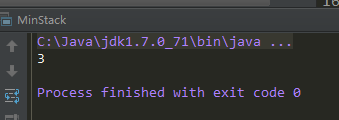
6、判断栈的push和pop序列是否一致:
通俗一点讲:已知一组数据1、2、3、4、5依次进栈,那么它的出栈方式有很多种,请判断一下给出的出栈方式是否是正确的?
例如:
数据:
1、2、3、4、5
出栈1:
5、4、3、2、1(正确)
出栈2:
4、5、3、2、1(正确)
出栈3:
4、3、5、1、2(错误)
完整版代码:
import java.util.Stack;/**
* Created by smyhvae on 2015/9/9.
*/public class StackTest { //方法:data1数组的顺序表示入栈的顺序。现在判断data2的这种出栈顺序是否正确
public static boolean sequenseIsPop(int[] data1, int[] data2) {
Stack<Integer> stack = new Stack<Integer>(); //这里需要用到辅助栈
for (int i = 0, j = 0; i < data1.length; i++) { stack.push(data1[i]); while (stack.size() > 0 && stack.peek() == data2[j]) { stack.pop();
j++;
}
} return stack.size() == 0;
} public static void main(String[] args) {
Stack<Integer> stack = new Stack<Integer>(); int[] data1 = {1, 2, 3, 4, 5}; int[] data2 = {4, 5, 3, 2, 1}; int[] data3 = {4, 5, 2, 3, 1};
System.out.println(sequenseIsPop(data1, data2));
System.out.println(sequenseIsPop(data1, data3));
}
}代码比较简洁,但也比较难理解,要仔细体会。
运行效果:
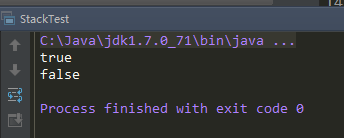

 随时随地看视频
随时随地看视频




